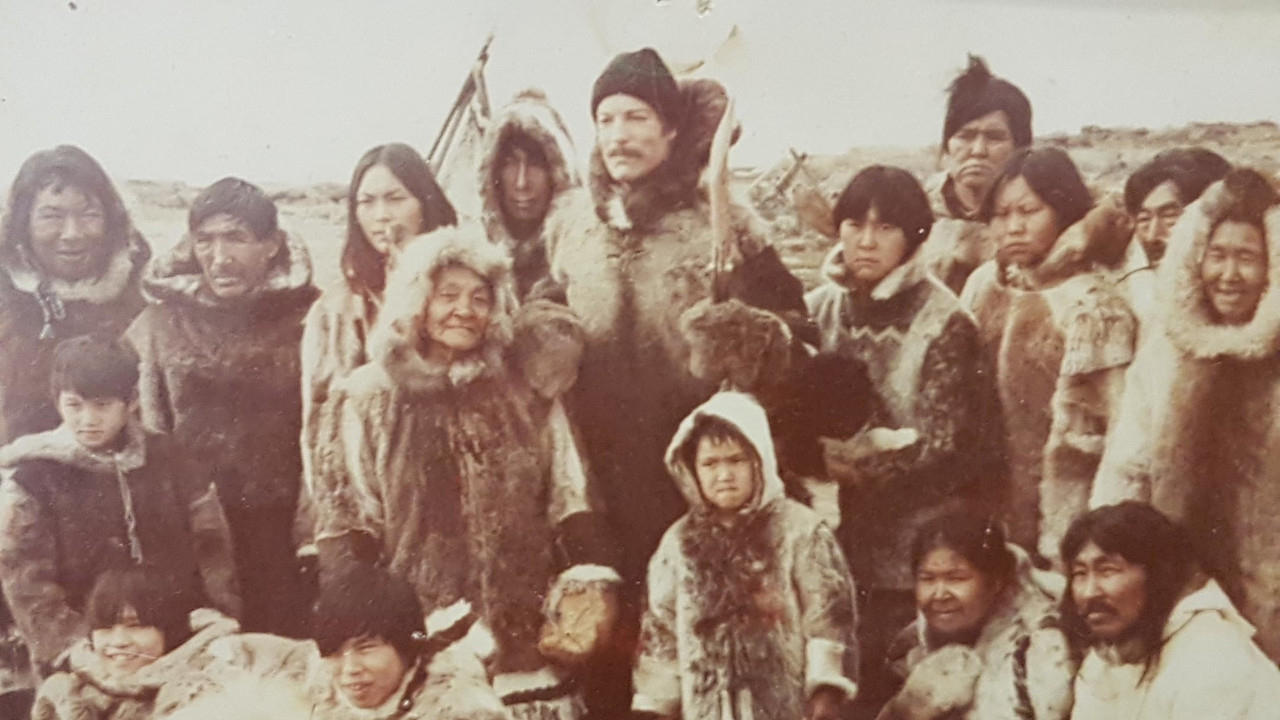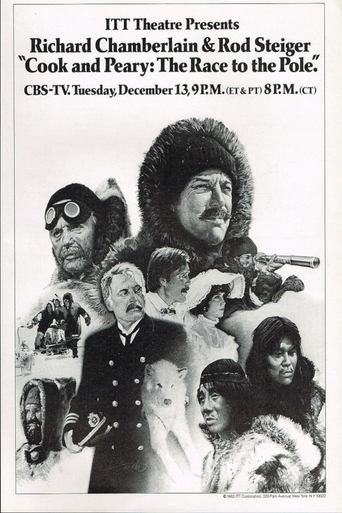

I saw this movie on TV in the mid 1980s. The story hits home in several ways. I attended Robert E. Peary Junior High School in Gardena, CA in the 1960s and from day one we were indoctrinated that "Peary was the first man to reach the North Pole," "Accept no substitutes," "He's it and that's that," etc., etc. Then, during Negro (1960s, remember) History Month, we found out that Matthew Henson did most of the grunt work but, because of his skin color, didn't get any credit (we were never able to get anything at the school named for him). Finally, in the summer of 1966 (my first after starting at Peary), I made my annual visit to my grandparents where my grandmother told me that Dr. Cook was a distant cousin of hers (at least a second cousin). When I brought this up with some of my teachers and classmates at Peary, I suddenly found myself at the top of the Special High Intensity Treatment (S.H.I.T.) list and, for the remainder of my time at Peary, received all the Special High Intensity Treatment that could be dished out on an individual. Teachers and students alike hated me for disrespecting the legacy of Admiral Peary when, simply enough, I was related to a woman who was related to Dr. Cook. Back to the movie...there was a lot of criticism of the casting. All-American good guy and "King of the Miniseries" Richard Chamberlain played Dr. Cook while All-American tough guy Rod Steiger played Admiral Peary. The story seemed to match the real life events...Dr. Cook claimed to have gotten there first but was discredited...Admiral Peary got the credit when, in reality, someone else did most of the work. Again, this movie was a good way to spend two hours...but it did open some emotional scars. For years (even into high school) I was treated as a pariah until it eventually subsided and life went on.
... View MoreIt is somewhat sad that for all the interest shown regarding the South Pole (the movie SCOTT OF THE ANTARCTIC, and the series THE LAST PLACE ON EARTH), the only film dealing with the great North Pole controversy of the same period is this mediocre retelling of the story from the point of view of die-hard Cook supporters. As such it puts the best spin on the case for Dr. Cook, but it leaves many issues unresolved. But first let me try to fill in the basic problem.Between 1890 and 1909 there were four explorations done by Lt. Robert Peary to the North Pole. Peary, a United States Naval Officer, had originally been involved in exploration in Nicaragua's jungles, looking over the possible routes for a transoceanic canal. He was assisted by a servant, Matthew Henson (a African-American). When Peary turned his attention to the Pole, he took Henson with him. They worked well together, but Peary saw that Henson could be good as a go-between with the native Inuits. However they went on the four journeys together, and Peary slowly got promoted to Commander, Commodore, and finally Rear Admiral (Henson rose in naval rank too, though never as high as Peary - however, among explorers Henson was widely respected and was a member of the Explorer's Club with Peary).Peary suffered on these journeys - he lost eight of his ten toes to frostbite. But he learned the lesson of the Arctic through Henson and the Inuits. You had to live off the land, and to travel like an Inuit to get through the Arctic. His determination to reach the North Pole won him many wealthy supporters in the U.S. But after each of the first three voyages (especially the third) there was increasing skepticism about whether the burning determination would help him nail the "big nail" (as the Pole was called).He certainly had many rivals - one was Fridjof Nansen, the great Norwegian explorer whose drift in the "Fram" in 1893 was one of the greatest scientific journeys in the golden age of Arctic exploration (1821 - 1928). Another was Nansen's younger Norwegian rival Raoul Amundsen, the first to sail through the Northwest Passage completely (1903 - 1905). Both of them intended to try to reach the Pole. So did some lesser explorers like Anthony Fiala. A Swedish aeronaut, Saloman Andree, disappeared in 1897 with two companions in an attempt to fly to the Pole (their remains were found in 1930).One unexpected rival was Dr. Frederick Cook. Dr. Cook had experience on an Antarctic Exploration in the 1890s, and had served as the medical officer on one of Peary's journeys. But he soon branched out on his own. In 1906 he announced at the Explorer's Club that he had reached the summit of Mount McKinley, and soon published TO THE TOP OF THE CONTINENT with photographs of his assent. Based on this he announced his intention to reach the Pole. This was upsetting to Peary, who felt he had first rights to it.The television film follows the journey of the two rivals in 1908 - 1909. It gets part of the story correct - although Peary is officially credited with reaching the North Pole on April 6, 1909 accompanied by Henson, the evidence is ... err..."spotty". It has not stood up too well, particularly sledding speeds and distances that have rarely been duplicated in the Polar areas by others. However, Cook by this time had returned to civilization and announced he reached the Pole in April 1908 accompanied by two Inuits.Here the film jumps totally into the pro-Cook camp, and never recovers it's balance. Cook did not document his trip too well either. The two Inuits said that he spent the period living with them among some islands in the North of Greenland (ironically, if Cook had told the truth about this, and published the results, his fame as a daring explorer might be greater now than if he had reached the Pole). Documents he claimed supported his travel speeds were left behind in Greenland. He claimed Peary should have brought them back, as he (Cook) requested. Quite rightly Peary had refused because (as he pointed out) if the documents did not support Cook's claim he would have been accused of tampering with Cook's records.Cook soon found that others were attacking him. Several mountain climbers tackled Mount Mckinley, and found massive holes in the story of Cook's climbing it in 1906 (one photo of him at the "summit" turned out to be a fake). By 1910 Cook's reputation was tattered. Subsequent actions by him, such as stealing credit for a Polynesian dictionary that a missionary wrote, and the sale of valueless oil stock in the 1920s (leading to a prison sentence) finished his credibility with most of the public. However a sizable number still insist that he did climb Mt. McKinley to the top and that he did reach the Pole, but because he was a poor individualist (and not - like Peary - supported by bloated rich men) he was traduced by his enemies.Richard Chamberlain and Rod Steiger give excellent performances as Cook and Peary. I recommend the film to see the pro-Cook argument. If they ever do a more even-handed account showing the defects of both explorers' claims it would be all to the better.
... View MoreExploration buffs are still arguing about Dr. Cook's credentials and Peary's claim to the North Pole. Chamberlain and Steiger are certainly more than qualified to portray these real life explorer's and it is a shame that scripting,direction and special effects give this film below average ratings, especially if one is a history buff.
... View MoreI'm not sure this TV movie has ever won the attention that it deserved, but this chronicles a true event that every man tried hard to accomplish, and failed: reaching the North Pole. The story provides conflict and competition between the two characters in the title who set out to make history for themselves. A different kind of expedition illustrates an observational point of view rather than adventurous. Richard Chamberlain didn't have to be so jealous enough to create a fool of himself, but he was. Let's cover up all of the important events that lead to the conclusion, which is downright spoilish and predictable for a movie that had a plot so nicely thought out. I'd be too foolish to tell you what exactly happened, but if you're interested in history that was thought to be impossible, then this'll be pretty good.
... View More